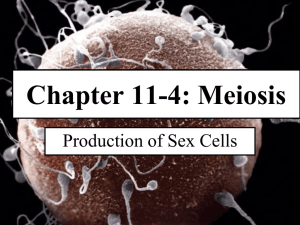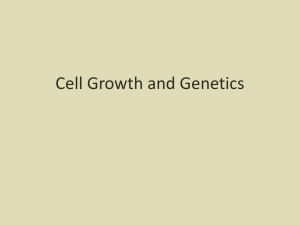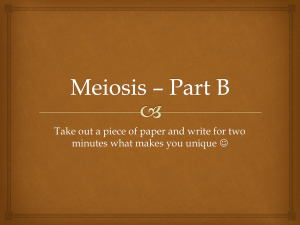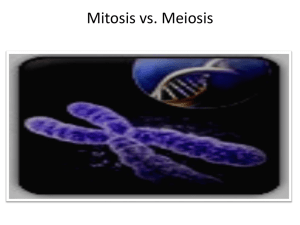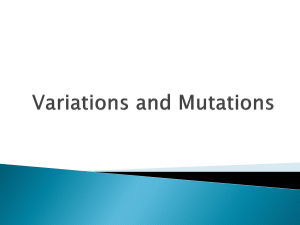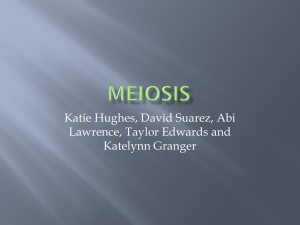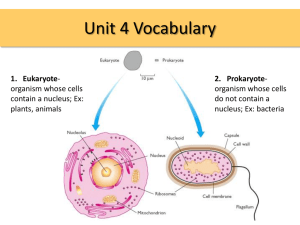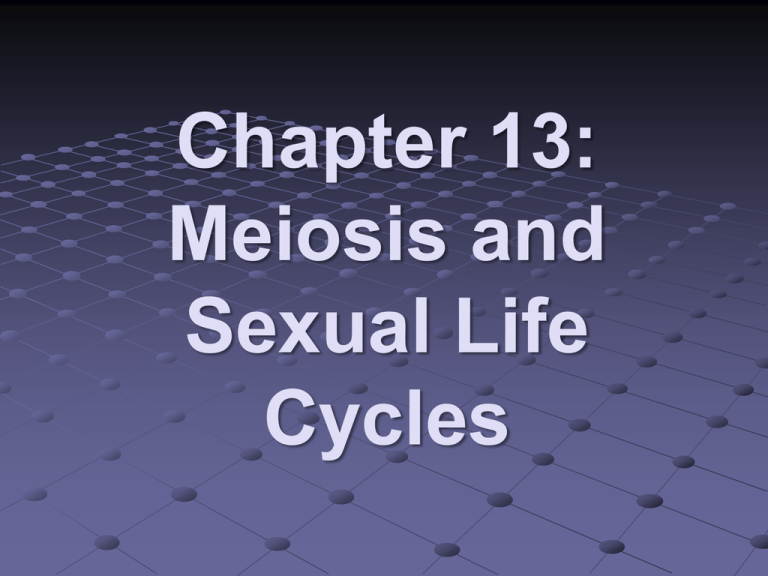
Chapter 13:
Meiosis and
Sexual Life
Cycles
Essential Knowledge
3.a.2 – In eukaryotes, heritable information
is passed to the next generation via
processes that include the cell cycle and
mitosis, or meiosis plus fertilization (13.113.3).
3.c.2 – Biological systems have multiple
processes that increase genetic variation
(13.4).
Heredity
The transmission of traits from
parents to offspring
Comment - Humans have been aware
of heredity for thousands of years
Also known as inheritance
Genetics
The scientific study of heredity
Comment - Genetics is only about
150 years old
NEW/MODERN field of science
DNA was only discovered in 1950s
Only 60 years ago!
Chromosome Review
Chromosomes (23 pairs=46)
Inherit one chromosome of each
pair from each parent
Total of 46 (23 maternal, 23
paternal)
1 pair/2 = Sex chromosomes
22 pairs/44 = Autosomes
Genes
The DNA for a trait
Locus - the physical location of a
gene in a chromosome
Genes program traits
How? Program cells (through protein
synthesis) to make specific proteins
These proteins become “visible” to
us through outside traits
Reproduction
A method of copying genes to pass
them on to offspring
Fertilization: male/female gametes
unite during reproduction
Results in zygote (fertilized egg)
Two main types:
Asexual reproduction
Sexual reproduction
Asexual Reproduction
Parent passes all of its genes to its
offspring
Offspring are exact copies of parents
Also known as cloning (clones)
Uses mitosis
Often called budding
Comment - many organisms
reproduce this way
Ex: jellyfish, hydra, sponges
Asexual Bud
Advantages of Asexual
Only need 1 parent
Offspring are identical to the
parent
Good genetic traits are conserved
and reproduced
Usually requires less energy
Why?
Disadvantages of Asexual
No new DNA combinations for
evolution to work on
Only genetic differences come from
DNA mutations (during DNA
replication, etc)
Clones may become extinct if
attacked by a disease or pest
Sexual Reproduction
Two parents contribute DNA to an
offspring
Comment - most organisms
reproduce this way, but it hasn’t
been proven in some fungi and a
few others
Sex Chromosomes
Homologous?
Mostly no! Only a SMALL part of
these 2 are homologous
Males: One X chrom, One Y chrom
Y chromosomes are smaller (with
more genetic disorders)
Females: Two X chromosomes
X chromosomes are bigger (usually
contain more genes)
Egg vs. Sperm
Eggs contain ONLY X
chromosomes
Sperm contain EITHER X or Y
chromosomes
Why?
Because boys (when they are made during
fertilization) get an X chromo from mom and a Y
chromo from dad – making them a MALE!
If the cell were to get two X chromos, the
fertilized cell would become a FEMALE!
Who determines sex of
baby?
Males determine what sex the
offspring will be
Why?
Their sperm have the “option” of
having X or Y
X from egg and Y from sperm = XY
(male)
X from egg and X from sperm = XX
(female)
Advantages of Sexual
Offspring has a unique
combination of DNA which may be
an improvement over both parents
New combination of DNA for
evolution to work with
Disadvantages of Sexual
Need two parents (requires time and
energy to look/find the right mate)
Good gene combinations can be
lost
Offspring may not be an
improvement over the parents
Question ?
Do parents give their whole DNA
copy to each offspring?
What would happen to the
chromosome number if they did?
Chromosome Number
Is usually constant for a species
Two of these are usually sex
chromosomes
XY or XX in humans
Examples:
Humans – 46 (pair #23 is sex)
Corn - 20
Onions - 16
Dogs - 72
Two options for life cycle…
1) Mitotic cell division continues life
2) Meiosis cell division continues life
WHICH way does life reproduce?
Result of Life cycle: if Mitosis
46 in egg + 46 in sperm=
92 total chromosomes
Chromosome number would
double each generation.
Need a method to reduce the
chromosome number.
Result of life cycle: if Meiosis
Egg 23 + sperm 23 =
46 total chromosomes
Chromosome number will remain
the same with each sexual
reproduction event.
Meiosis is used to produce the
gametes or sex cells.
46 reduced to 23 through meiosis
Meiosis - Purpose
To reduce the number of
chromosomes by half
46 to 23 (in humans)
Prevents doubling of chromosome
numbers during sexual
reproduction
Sexual Life Cycle
Has alternation of meiosis and
fertilization to keep the
chromosome numbers constant for
a species
Fertilization: 23 + 23 = 46 total
Mitosis: takes original cell made through
fertilization and multiplies it to form organs,
etc.
Meiosis: 46 reduced to 23 (in sex organs)
Life Cycle Variations
Diploid
2 sets of chromosomes
Referred to as 2n
Most common number in body or
somatic cells
Humans 2n = 46
Corn 2n = 20
Fruit Flies 2n = 8
Haploid
1 set of chromosomes
Number in the gametes or sex cells
Humans n = 23
Corn n = 10
Fruit Flies n = 4
Half of diploid #!!!!!!!
Polyploids
Multiple sets of chromosomes
Examples
3N = triploid
4N = tetraploid
Common in plants, but usually
fatal in animals
Ex: Down Syndrome
Ex: Seedless watermelons
Triploid Daffodil =
more stem produced
per bulb
Triploid
watermelon = no
gametes produced
(no seeds)
Meiosis/Mitosis Preview of
differences
LOOK at pg. 256
Meiosis
Two cell divisions, not one
Four cells produced, not two
Synapsis and chiasmata will be
observed
Meiosis/Mitosis Preview of
differences
Meiosis, cont.
1st division separates PAIRS of
chromosomes, not duplicate
chromatids (of chromosome)
Known as homologous pairs of
chromosomes
Mitosis vs.
Meiosis
Interkinesis is present.
Animation
Meiosis
Has two cell
divisions (I and II)
Steps follow the
names for mitosis
A “I” or “II” will be
added to label
Replicated
chromatids
(dupl. during
Inter)
Prophase I
Basic steps same as in prophase of
Mitosis.
Synapsis occurs as the chromosomes
condense.
Synapsis - homologous chromosomes
form bivalents or tetrads
Synaptonemal complex - proteins which
hold chromosomes together
Tetrad
Prophase I, cont.
Chiasmata observed
Spot where chromatids cross-over
Held together by this until Anaphase
Longest phase of division
Cell spends 90% of meiosis in this stage
Chromatin condenses, nucleolus
disappears, nuclear envelope
dissolves
Metaphase I
Tetrads or bivalents align on the
metaphase plate
Attached to kinetochores of opposite
poles
Centromeres of homologous pairs
point toward opposite poles
Anaphase I
Homologous PAIRS separate
Uses spindle apparatus
Duplicate chromosomes are still
attached at the centromeres
Maternal and paternal
chromosomes are now separated
randomly
Telophase I
Similar to Mitosis
Chromosomes may or may not
unwind to chromatin
Cytokinesis separates cytoplasm and
2 cells are formed
NOW:
Each cell has a haploid set of chromosomes
Each chromosome is STILL comprised of 2
identical sister chromatids!!!
Interkinesis
No DNA synthesis/copying occurs
May last for years, or the cell may
go immediately into Meiosis II
Can appear similar to Interphase of
Mitosis
Meiosis II
Steps are the same as in Mitosis
Prophase II = Prophase
Metaphase II = Metaphase
Anaphase II = Anaphase
Telophase II = Telophase
Meiosis - Results
4 cells produced
Meiosis
animation
Each cell has ONE sister chromatid
Remember: Started with homologous
chromosome PAIR
Chromosome number reduced
Gametes (sex cells) made
Genetic variation increased
Sexual Sources of Genetic
Variation
1. Independent Assortment of
Chromosomes during Meiosis
2. Random Fertilization
3. Crossing Over
Independent Assortment
There are 23 pairs of
chromosomes in humans
The chance to inherit a single
chromosome (maternal or paternal)
of each pair is 1/2
Random arrangement of homologous
pairs during metaphase I
This arrangement is totally random!
Gamete Possibilities
With 23 pairs of chromosomes, the
number of combinations of
chromosome types (paternal and
maternal) are:
23
2
or 8,388,608
(w/ each offspring!)
Random Fertilization
Choice of which sperm
fuses with which egg
(random choice)
With 8,388,608 kinds of
sperm and 8,388,608
kinds of eggs, the
possible combos of
offspring is over
64 million (for EACH
set of parents)
Crossing-Over
The exchange of sister chromatid
material during synapsis
Occurs ONLY in Prophase I
Produces recombinant chromosomes
Chromosomes with DNA from both
parents
Chiasmata:
The point of contact where two
chromosomes are crossing-over
Importance
Breaks old linkage groups
Creates new linkage groups
increases genetic variation
Very common during meiosis
Frequency can be used to map the
position of genes on
chromosomes
Comments
Offspring can never be 100% like a
parent if sexual reproduction is
used
Multiple cross-overs are common,
especially on large chromosomes
Genes near the centromere do not
cross-over very often
Summary
Recognize the general relationships between genes,
DNA, and chromosomes.
Identify characteristics, advantages, and limitations of
asexual and sexual reproduction.
Recognize several sexual life cycles differing in the
timing of meiosis and fertilization.
Recognize the stages and characteristics of the meiosis
cell division process.
Contrast and compare meiosis to mitosis.
Identify sexual sources of genetic variation.
Use Chapter 46 to see differences in male/female
meiosis (pgs. 1006-1007)


